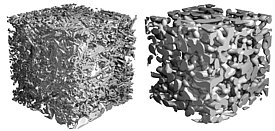23.01.2025 | Sergi González-Herrero | SLF News
SLF scientist Sergi González-Herrero is conducting research in Antarctica for two months. From there, he regularly reports in Catalan for the Catalan Foundation for Research and Innovation (FCRI) to get young students aged between twelve and sixteen involved in science. The SLF also publishes his articles.
It's time to explain why I'm here. I'm a meteorologist and I worked as a weather forecaster at the Spanish Meteorological Service, or AEMET. During my years at AEMET I did my Doctorate on precipitation in the Pyrenees which, of course, included snow. During this period, I had the opportunity to participate in three Antarctic campaigns in the Antarctic Peninsula. When I decided that I wanted to do research full-time, I found a position on interactions between snow and the atmosphere at the WSL Institute for Snow and Avalanche Research SLF in Davos that suited what I had done previously. So, there I went, and I am very happy to work in such thrilling research atmosphere. But you may be wondering: What does he mean by interactions between snow and the atmosphere? The atmosphere, the air we breathe, seems to have no effect on the surface, but it is constantly exchanging energy and elements. The clearest example is with rain. If it rains the ground gets wet, and if it is sunny and hot the ground dries out. The same thing happens with snow. If it is sunny and the temperature is high the snow melts and if it's very cold, even though you can't see it, the snow changes.
That's why we study snow, it's an exceptional substance, with many hidden properties. Did you know that snow is a very hot material? No, I haven't gone crazy. From a materials point of view, snow is warm. What I mean is that it is always at a temperature very close to the melting temperature, where it becomes water. To give you an example, iron becomes liquid at 1538 °C; therefore, if we are in the summer at 38 °C we still need 1500 °C to fuse the iron. On the other hand, snow becomes liquid at 0 °C, and if we are at -15 °C we only have 15 °C left to melt it. This means that snow, whatever its temperature, is always very, very close to melting, and this makes it one of the warmest substances from a materials point of view. But you can read more about this in this fantastic post of my colleagues Martin and Ruzica.
But let's get back to my project here. I don't study snow itself as a material, other colleagues at the SLF do that. As I said before, I study its interaction with the atmosphere, and specifically one of the most unknown and difficult interactions, what happens when snow is lifted by the wind. This is what we call “blowing snow”. Here you can see a blowing snow day from the station.
Blowing snow occurs very often in Antarctica and is a very important source of sublimation of snow. What does sublimation mean? Sublimation is when snow evaporates directly without turning into liquid water. This often happens in very cold areas. And it is very important to understand this process to improve our measurements and predictions of how much ice is lost each year in Antarctica. My research group has been measuring the blowing snow in Antarctica for several years from a few stations with specific instruments. However, these stations are on the surface and with them we cannot understand what is happening in the upper layers of the blowing snow cloud. That is why we will do measurements from a tower with different instruments at different heights; but I will tell you about that in the next entry of the research diary. For now, I have started extracting the data obtained during the winter and digging up the already assembled meteorological station. One of the most common jobs for a snow scientist is – you probably guessed it – shovelling snow. It is very tiring but also quite fun. Here you can see how I try to free the meteorological station from snow and then to raise it (I eventually needed help to raise it more since I didn’t quite manage it on my own):
I have also been preparing all the material to install and I have made last minute changes to the station. Now everything is ready to start, and I hope to start installing all the instruments soon.
Already published: ¶
Copyright ¶
WSL and SLF provide image and sound material free of charge for use in the context of press contributions in connection with this media release. The transfer of this material to image, sound and/or video databases and the sale of the material by third parties are not permitted.

